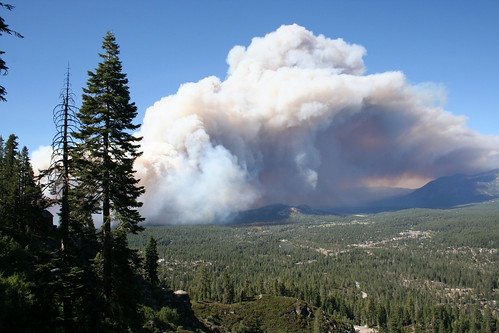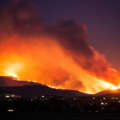
Photo by frostyeli at Flickr.
So I go away for the weekend, and I come back to wildfire, smoky skies, and massive destruction. This is what happens when I leave you alone for a few days?
The Angora Fire started in the hills south of Lake Tahoe around 2:00 Sunday afternoon, and within hours it had exploded, traveling north along the Angora Ridge (hence the name) and sweeping down into the populated valley below. By nightfall most of the damage was done, over 150 houses burned and many more damaged (the Record Courier has a list). The fire is still burning up in the hills today, and is approaching 3,000 acres, but firefighters have a pretty good handle on it now and it should be fully contained soon. But for those affected, the hard work is just starting.

An air tanker heading out from Minden to do battle.
The area the fire swept through, and where the homes were destroyed, is along North Upper Truckee Road in the area of Meyers. Here’s a Google Map of the area so you don’t have to go searching. It’s the last real neighborhood you run into as you’re heading out of the Tahoe area along Hwy 50, and as such it buts right up against the Sierra wilderness. As is the case with much of the Tahoe Basin, there was never any major fuel reduction program undertaken in this area. So the conditions were right for a tiny spark to grow into a big flame, and the perfect combination of a dense understory and ample ladder fuels caused the fire to quickly become that most intense of fires, a crown fire. A crown fire is when the flames get up into the treetops, and from there there’s nothing stopping them from riding the canopy like a surfer rides the waves, leaping from tree to tree, safe from the limited reach of the firefighters below. Once the fire gets up there, you can’t do anything but watch it.

Photo by jakefields at Flickr.
As the Nevada Appeal points out, this is the “catastrophic fire” everyone has feared. Lake Tahoe has been a tinderbox for decades now, and that many people combined with that much dry fuel will lead to a bad end sooner or later. But really, this fire turned out to be not so bad, all things considered. When you travel up to Lake Tahoe, and you look at the hundreds of thousands of acres of dry and dead trees up there, when you read the studies my company put together on worst case scenarios for the Tahoe basin, you realize that things could have been a lot worse. A “catastrophic fire” doesn’t stop at 3,000 acres. It burns 3,000 acres the first day, then keeps going. It’s fueled by winds, drought, and a limitless supply of fuel. It spreads out in every direction, spreading firefighters thin as they’re battling the flames on three or four fronts. It lasts for days, or weeks, and threatens to make a grand circle tour of the whole basin, destroying everything it comes across. That’s the catastrophic fire I see in store for the Tahoe area. The Angora Fire turned out to be a moderately small blaze, its destruction magnified only by the fact of where it happened to start and how many houses it took out along the way.
Already the finger-pointing has started. The exact cause of the fire hasn’t been found yet, although it’s sure to turn out to be man-caused. So in lieu of an actual culprit, angry residents have found a suitable scapegoat and are instead rising up against the TRPA, who they say have prevented them from creating defensible space around their homes. There was a very volatile meeting at South Tahoe Middle School last night. There were, of course, nothing but cheers and applause for the firefighters out there doing the difficult work of slowing the fire down and keeping houses safe. But when the TRPA spokesman took the mic, he was booed off the stage. Residents have long said that there is too much red tape involved with clearing trees and brush off your land, and that the TRPA recommends clearing land to create defensible space with one hand, but then makes it impossible to actually cut down any trees with the other. The TRPA’s spokesman’s claims that tree removal is allowed was met with cries of “Bullshit!” (or, according to the newspaper, “an expletive involving bovine excrement”). And at least one resident is considering bringing a class action lawsuit against the agency for being too heavy-handed in their policies.
All of this, though, just dances around the paradox that people have been trying to solve for decades. Our first impulse when we see a fire is to put it out, to stomp it down before it threatens homes or our scenic getaway spots. But the fact is, fire is healthy for a forest. Forests need frequent small fires to keep them from getting too overloaded, too full of brush and small trees. Before we invented fire trucks and air tankers and other methods of suppression, there used to be large parts of the forest on fire at any given time, fires that would smolder for days up high in the mountains where men never ventured. And having these small fires kept the forests in balance and prevented large fires from happening very often. But now that we do venture up high in the mountains, it’s unthinkable to allow a fire to just roam around the Tahoe Basin unchecked. So the forest grows thicker, and the understory gets more dense, and there are more ladder fuels, and we have far fewer fires these days, but when we do have them they’re more likely to erupt into crown fires and full-blown conflagrations. And people love living in the forests, but when the forests burn, and they will burn, that’s what forests are meant to do, the houses burn with them.
There aren’t any easy answers here, just the question that keeps coming up over and over every time there’s a big wildfire: how can we prevent this in the future? How we make sure there isn’t another Angora Ridge fire? Or another Waterfall Fire? Or another Autumn Hills fire? We’re working on it, but I don’t think there is any good news. There will always be catastrophic fires, and our best is all we can do.
Web resources on the fire:
YouTube has some good videos of the fire, including this one with some distance shots of the smoke, and this one which has some good close-up views of the firefighters and flames, but only if you mute your speakers. More videos can be found here.
The Nevada Appeal has a slideshow of pictures by Dan Thrift, who is inside the burned area photographing the destruction.
Lots of people are putting pictures up on Flickr, mostly photos of the smoke plume from various points around the lake. Search for tahoe fire or angoraridgefire.
Donations are being accepted for fire victims at Casino Fandango, the Eagles Wings Christian Fellowship on Snyder, Carson Valley Christian Center on Stephanie Way, and many places at the Lake. Read the article for a full list.
And, on any of those Nevada Appeal links, scroll to the bottom to the “Related Articles” section for more of their full coverage. They’re been doing a good job at covering all facets of the fire and its effects, and even keeping their homepage updated every couple of hours. I still think their site should be more of a blog format, especially during big events like this, but they’re doing okay with what they have.
The blogosphere is on it, too: Mountain Moxie, No Safe Place, and Reno Realty Blog.
InciWeb has a page on the fire that they try to keep updated as the firefighting efforts make progress. It also includes maps of the burned area.




Scott,
We’ve been working as well as we can with the resources we have in the Summer to keep updated information aggregated, as well as posting photo slideshows from Flickr users up on OurTahoe.org. Feel free to check it out and point us to anything you think we should know about.